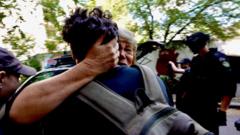The Human Toll of Conflict: Evacuations Amidst Drone Attacks in Eastern Ukraine
 The Tech Times
The Tech Times
The conflict in Eastern Ukraine has reached a critical juncture, with the region of Donetsk once again under the spotlight. As tensions escalate, civilians are caught in the crossfire, and the urgency of evacuation efforts becomes starkly apparent. Quentin Sommerville's report from the field provides a vivid glimpse into the harrowing reality faced by those living in a warzone, painting a picture of both desperation and resilience.
The Escalating Crisis
Donetsk, a key region in Eastern Ukraine, has been a focal point of conflict since the 2014 annexation of Crimea by Russia. The ensuing years have seen intermittent skirmishes and a fragile ceasefire, but recent developments have reignited fears of a broader confrontation. Russian President Vladimir Putin's interest in controlling this area is well-documented, and the current wave of drone attacks underscores the strategic significance of Donetsk.
Volunteers are now at the frontline, conducting urgent evacuations to protect civilians from the relentless assault. These efforts highlight the human dimension of war, where behind every statistic is a personal story of survival and loss.
Historical Context and Strategic Importance
The conflict in Ukraine is deeply rooted in historical, cultural, and geopolitical complexities. Donetsk, part of the Donbas region, has long been an industrial hub with a significant Russian-speaking population. This demographic factor has been a point of contention, exploited by pro-Russian separatists and used to justify external interference.
The region's vast coal reserves and industrial capacity add another layer to its strategic importance. Control over Donetsk not only offers economic leverage but also serves as a geopolitical chess piece in the broader struggle between Russia and the West.
The Role of Technology in Modern Warfare
The use of drones in the current conflict marks a significant evolution in warfare tactics. Drones provide a cost-effective means of surveillance and attack, allowing for precision strikes and real-time intelligence gathering. Their deployment in Donetsk underscores a shift towards more technologically advanced forms of combat, where traditional military engagements are increasingly supplemented by remote-controlled warfare.
The implications of this technological shift are profound, raising questions about the future of conflict and the ethical considerations of autonomous weaponry. As technology continues to advance, the rules of engagement must adapt to ensure accountability and minimize civilian casualties.
The Humanitarian Response
Amidst the chaos, the efforts of volunteers and humanitarian organizations stand out as a beacon of hope. These individuals risk their lives to evacuate residents, providing essential services and support to those most in need. Their work is not only a testament to human compassion but also a critical component of the broader humanitarian response to the crisis.
The international community's role in supporting these efforts cannot be understated. Diplomatic pressure, economic sanctions, and humanitarian aid are vital tools in addressing the immediate needs of the affected population and working towards a long-term resolution.
Conclusion: A Call for Peace and Resolution
The situation in Donetsk is a poignant reminder of the human cost of conflict. As drone attacks rage and evacuations continue, the need for a peaceful resolution is more urgent than ever. The international community must prioritize dialogue and diplomacy to prevent further escalation and support the people of Ukraine in their quest for peace.
The story of Donetsk is one of resilience in the face of adversity, and it is essential that we amplify these voices and work towards a future free from the shadows of war.
Source: Inside Donetsk as residents flee attacks on Ukrainian region Putin wants to control
Subscribe to my newsletter
Read articles from The Tech Times directly inside your inbox. Subscribe to the newsletter, and don't miss out.
Written by
